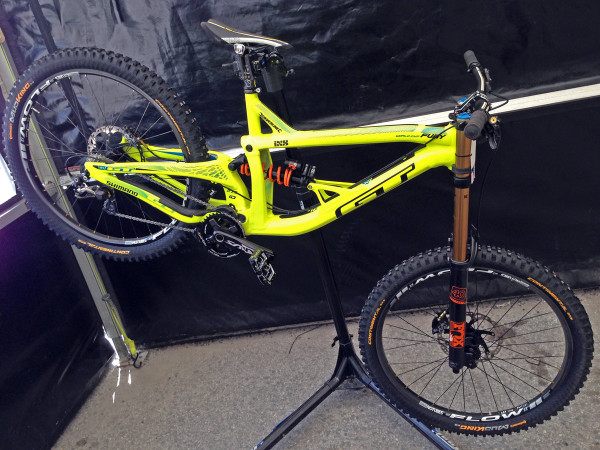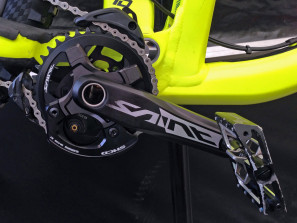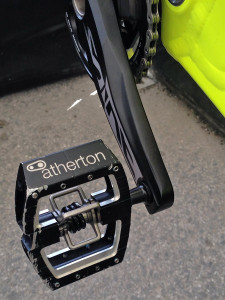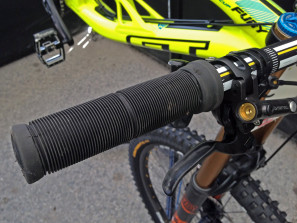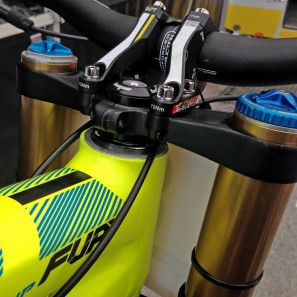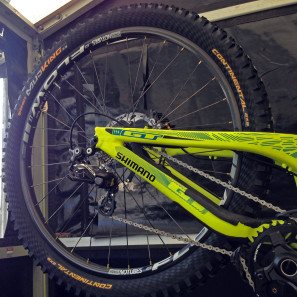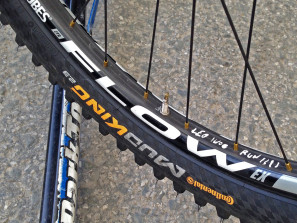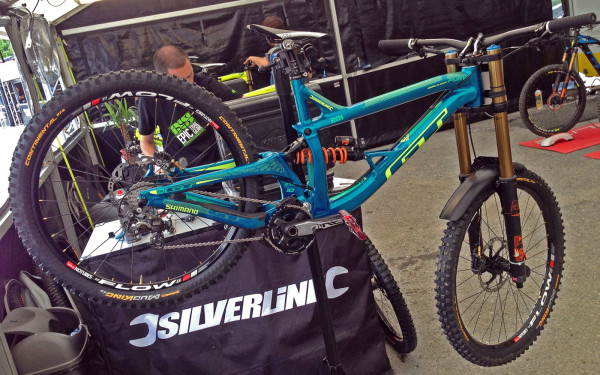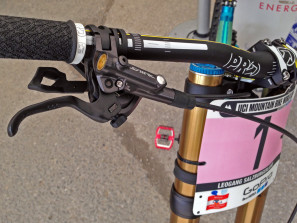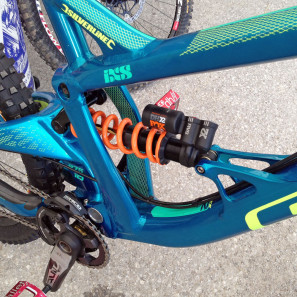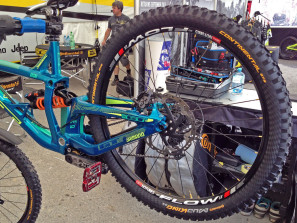The guys on the GT Factory Racing team all ride the Fury World Cup in this super bright yellow team edition. Reigning World Champion Gee Atherton has ridden this bike to two World Cup podiums so far this year, while his sister and teammate Rachel Atherton placed second in the first World Cup, before going on to win the next three rounds. The teams’ frames themselves are pretty much the 2015 stock 6069 aluminum 27.5″ production units, but suspension duties front and rear are handled by new model year 2016 bits from Fox.
We sat down with the team and mechanics for a little inside look at Gee and Rachel’s World Cup setups. Jump past the break for an up close look at what sets their bikes apart…
The world champ got a fresh new Saint group in time for the 3rd round of the World Cup, but stuck with mostly standard components. The team does opt for a bit of extra rubber stuck on the chainstay to keep the alloy bike quiet. And Gee gets a set of custom labeled Mallet DH Race pedals from Crankbrothers that don’t look too beaten up after just a few races into the 2015 season. Both Gee and Rachel run the same pedals and seem to like to keep the retention pins set pretty low to make getting in and out of the pedals fast and easy.
Gee’s contact points stick mostly to their eponymous Atherton Star Series of components from PRO, including DH bar, direct mount stem, saddle, and seatpost. He does however opt for a more old-school wired-on grip. Not quite slam your stem territory here, but it gets close as the team uses a reducer Hope headset to fill out the straight 1.5″ steerer of the aluminum Fury.
Sneakily labeled as Flow EXs, we spotted these prototypes of the new 32mm wide carbon rims that we showed a couple of weeks back and should be available to buy in the $1900 ZTR Bravo wheelsets any day now. While Stan’s bills these as Trail or Enduro wheels, they were developed in partnership with the Athertons and have been raced to several DH podiums already. Building them out of carbon, Stan’s was able to develop a rim that could deflect elasticly 10mm without damage, which allows these pro downhillers to run lower tire pressures for better traction with less of a risk of flatting when they bottom out. This addresses an issue we’ve heard repeated a lot from the XC side, where super stiff carbon wheels are not deflecting enough, and actually requiring racers to increase tire pressure to avoid pinch flats even set up tubeless.
The video above shows only the 7mm deflection of the Valor when fully tensioned. Just imagine 3mm more for the Bravo carbon hoops.
Rachel gets her similarly mostly stock GT Fury World Cup in a nice Atherton Racing special team blue, which she has now raced to three-in-a-row World Cup wins after Round 4 in Lenzerheiden. She rides a more well worn Saint groupset in a classic example of don’t mess with what works. The mechanics in these bigger top-level teams are often telling us that they don’t really need to resort to any crazy setups, as the newest bikes, groupsets, and suspension are offering them so much performance out of the box. It doesn’t hurt to have some talented riders too, we guess.
Rachel’s bike does spend a lot of time with a number one strapped to the front. Her cockpit stays completely with the PRO Atherton Star Series components from grips, DH bar, and direct mount stem to saddle and DH seatpost. A lot of lines on the PRO Atherton team bars help Rachel’s mechanics set her brakes and shifters up exactly every time, which goes a long way to prevent arm pump in these intense DH courses.
Suspension is handled by the new for 2016 Fox 40 FLOAT FIT4 fork and Fox DHX2 shock with external high and low speed rebound and compression adjustments, and the new rod valve system (RVS). And like the rest of the team Rachel sticks with actual Flow EX aluminum wheels and again Conti Mud King tires in new for 2016 27.5 x2.3″.
